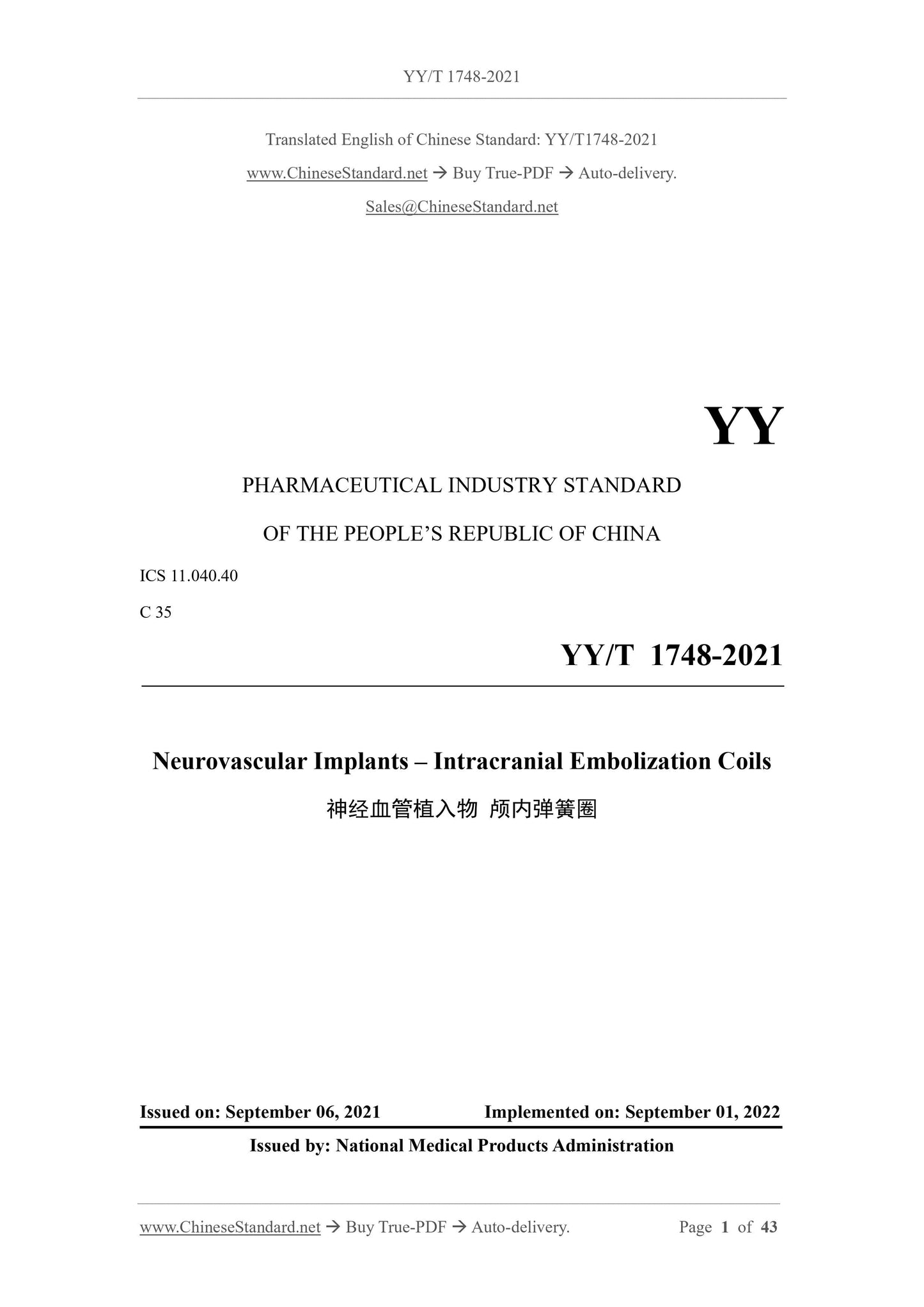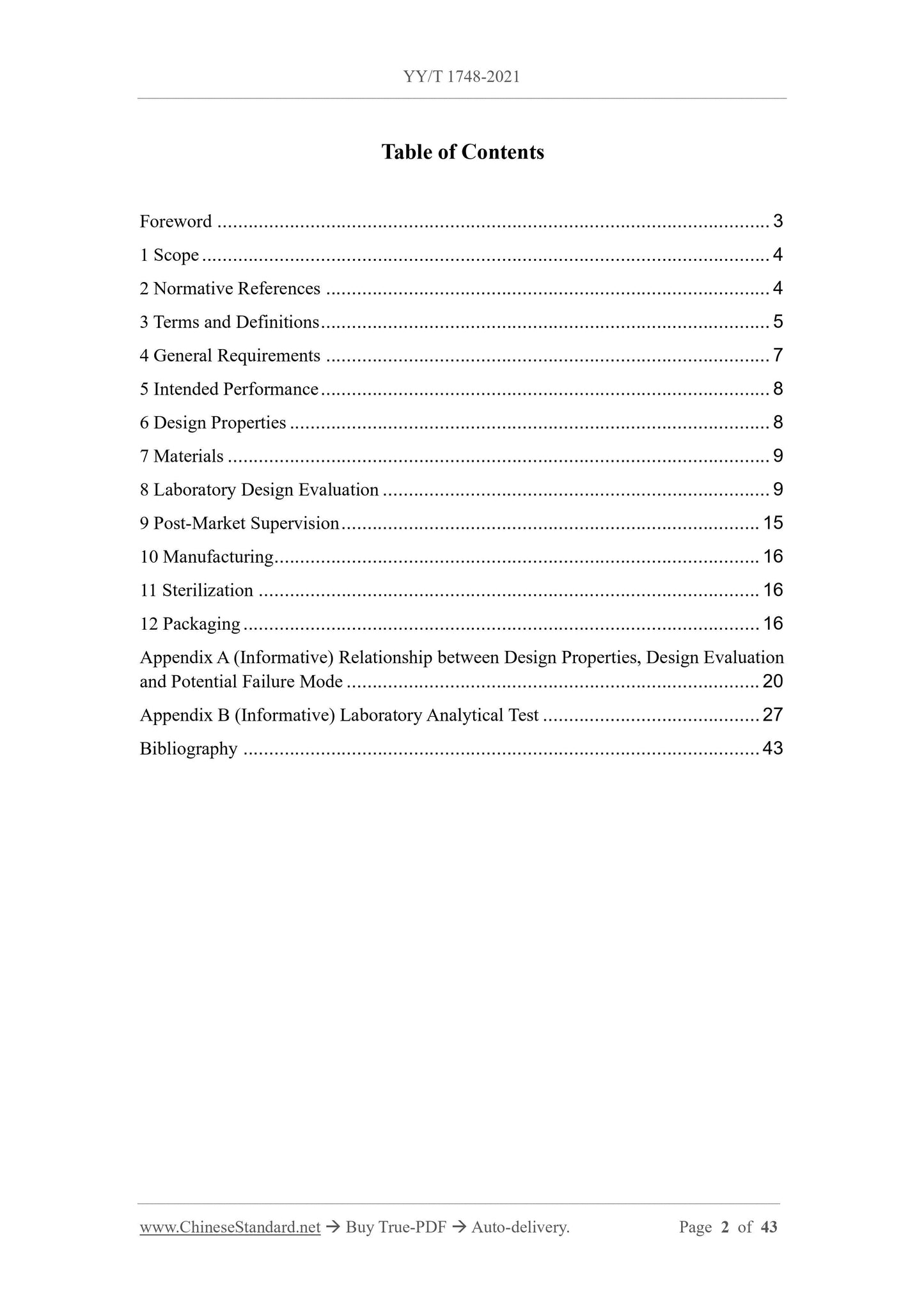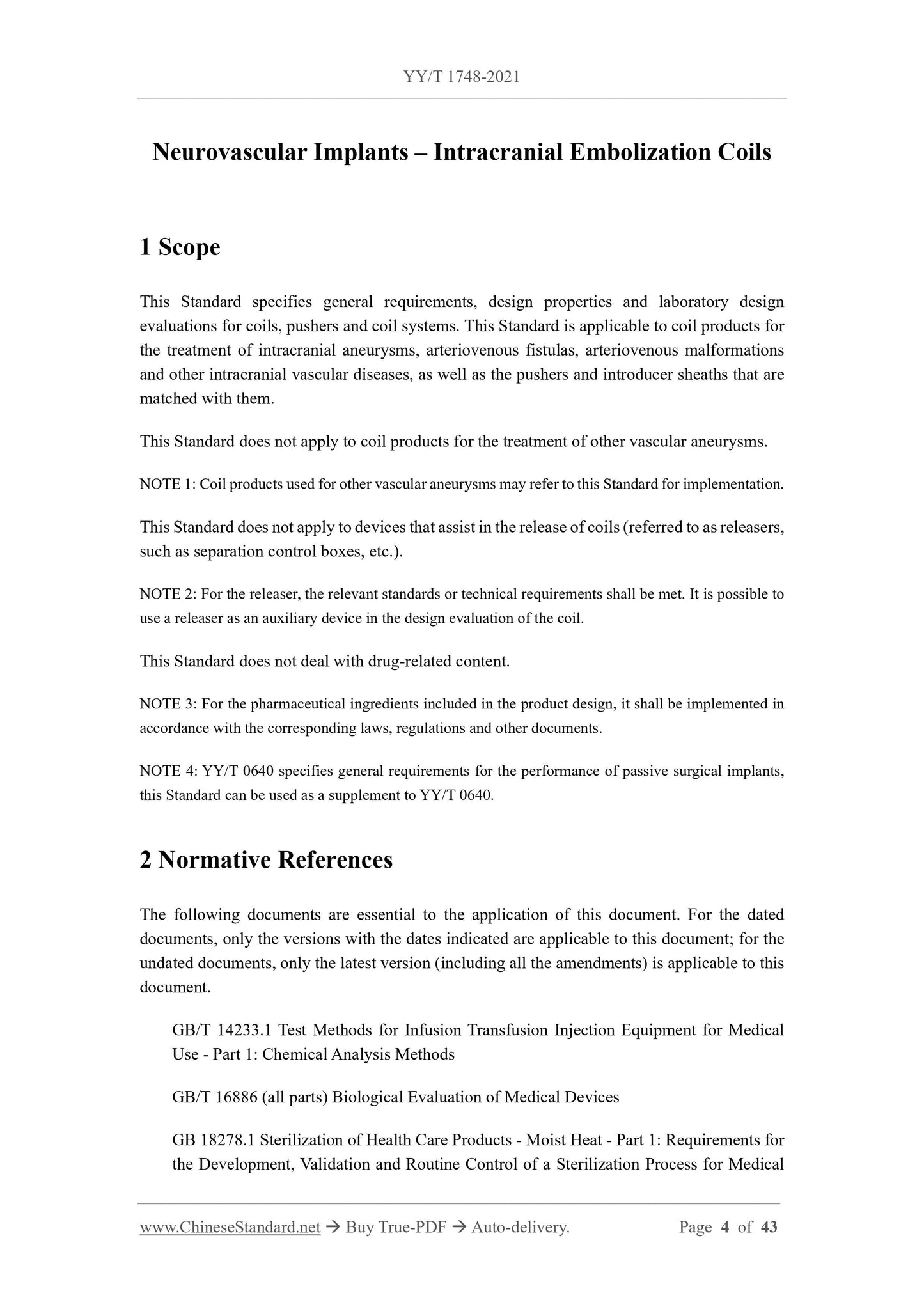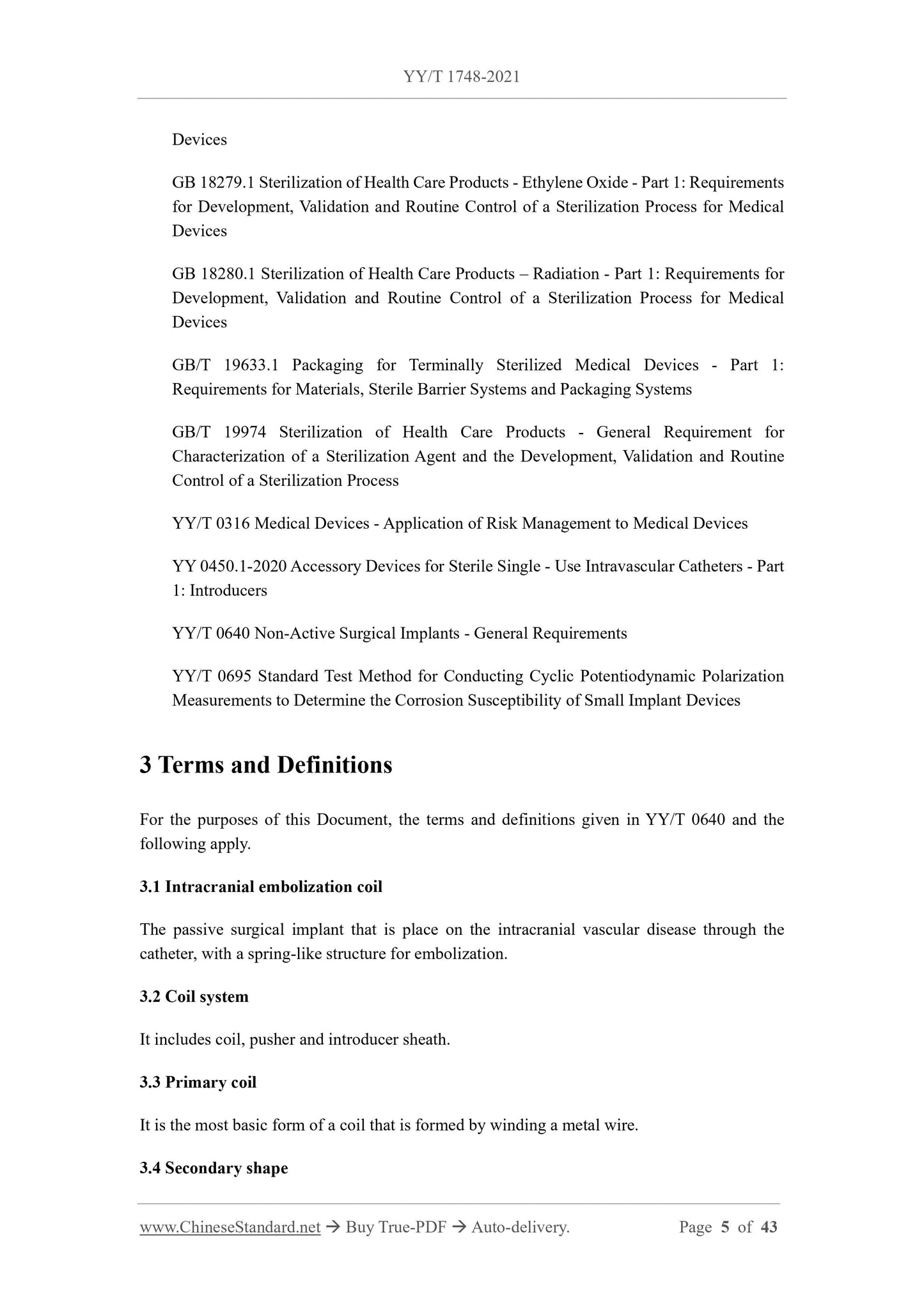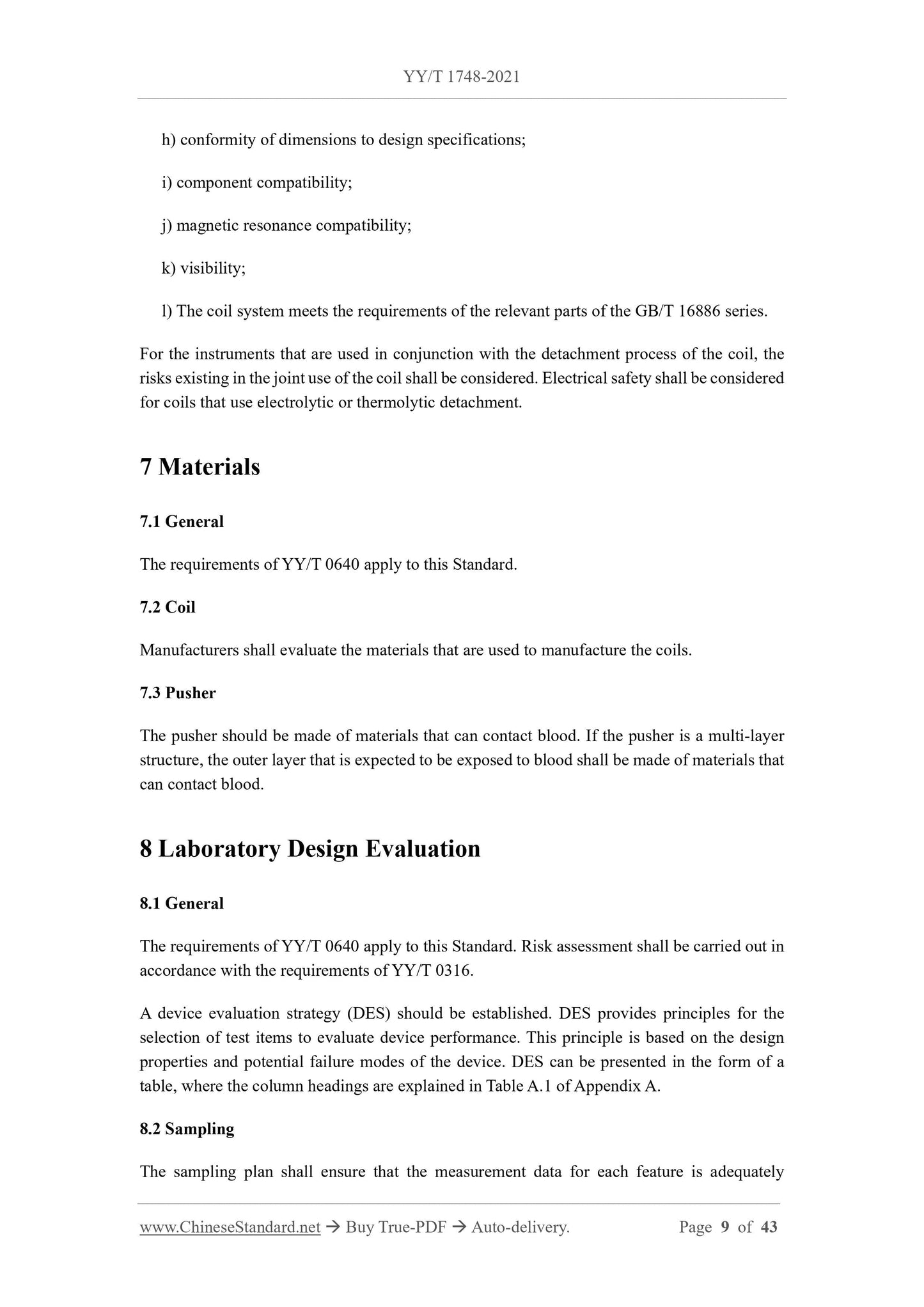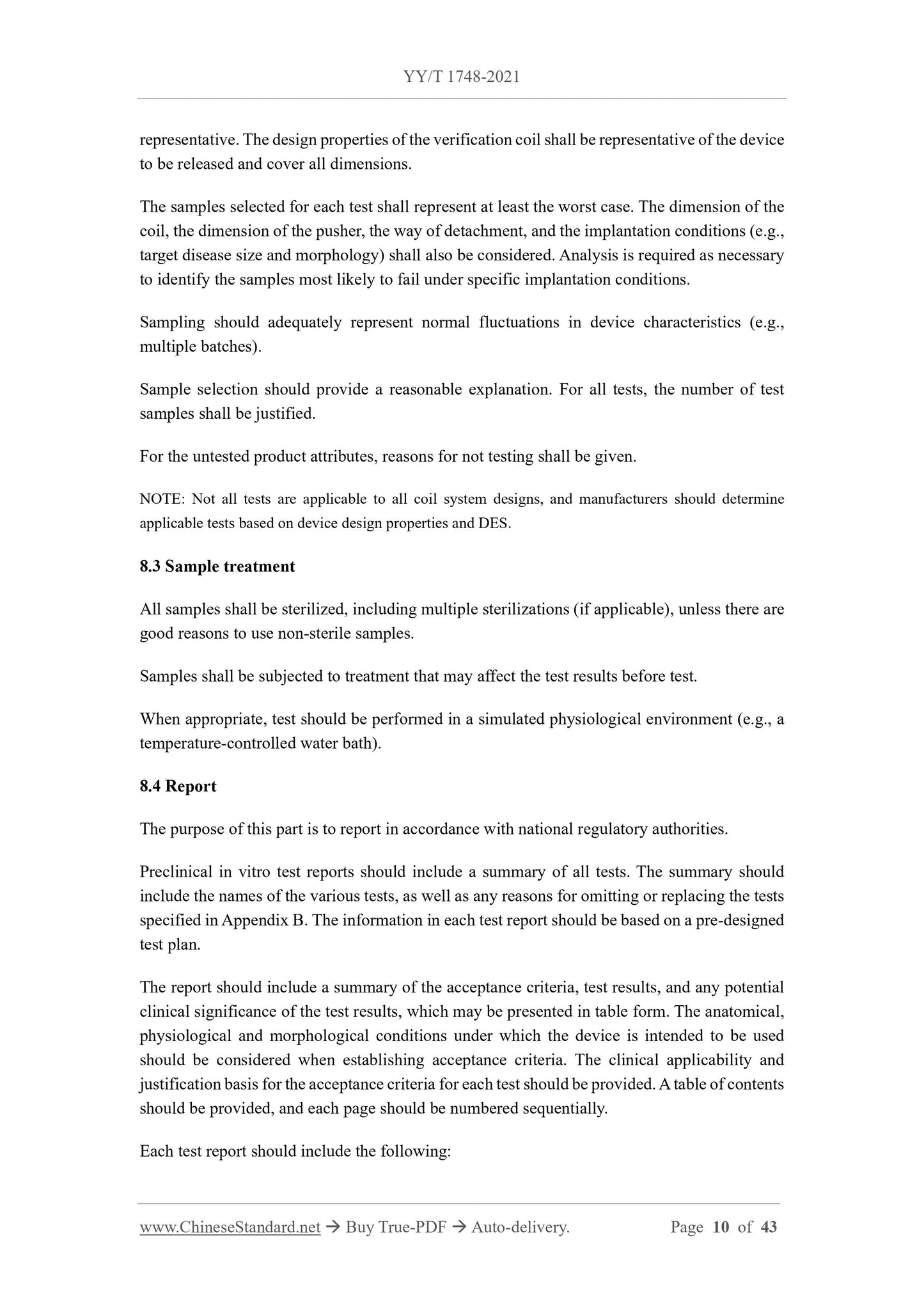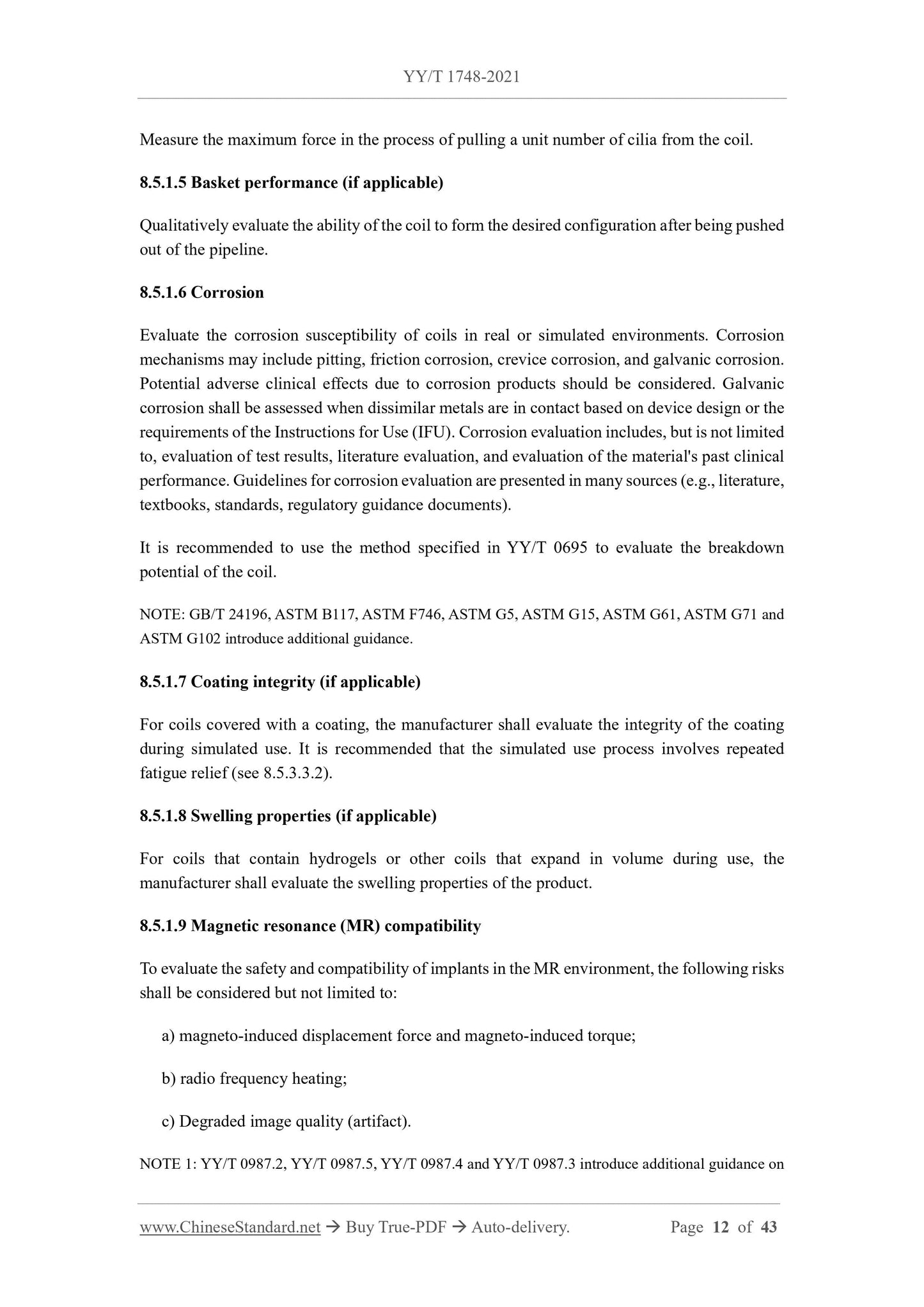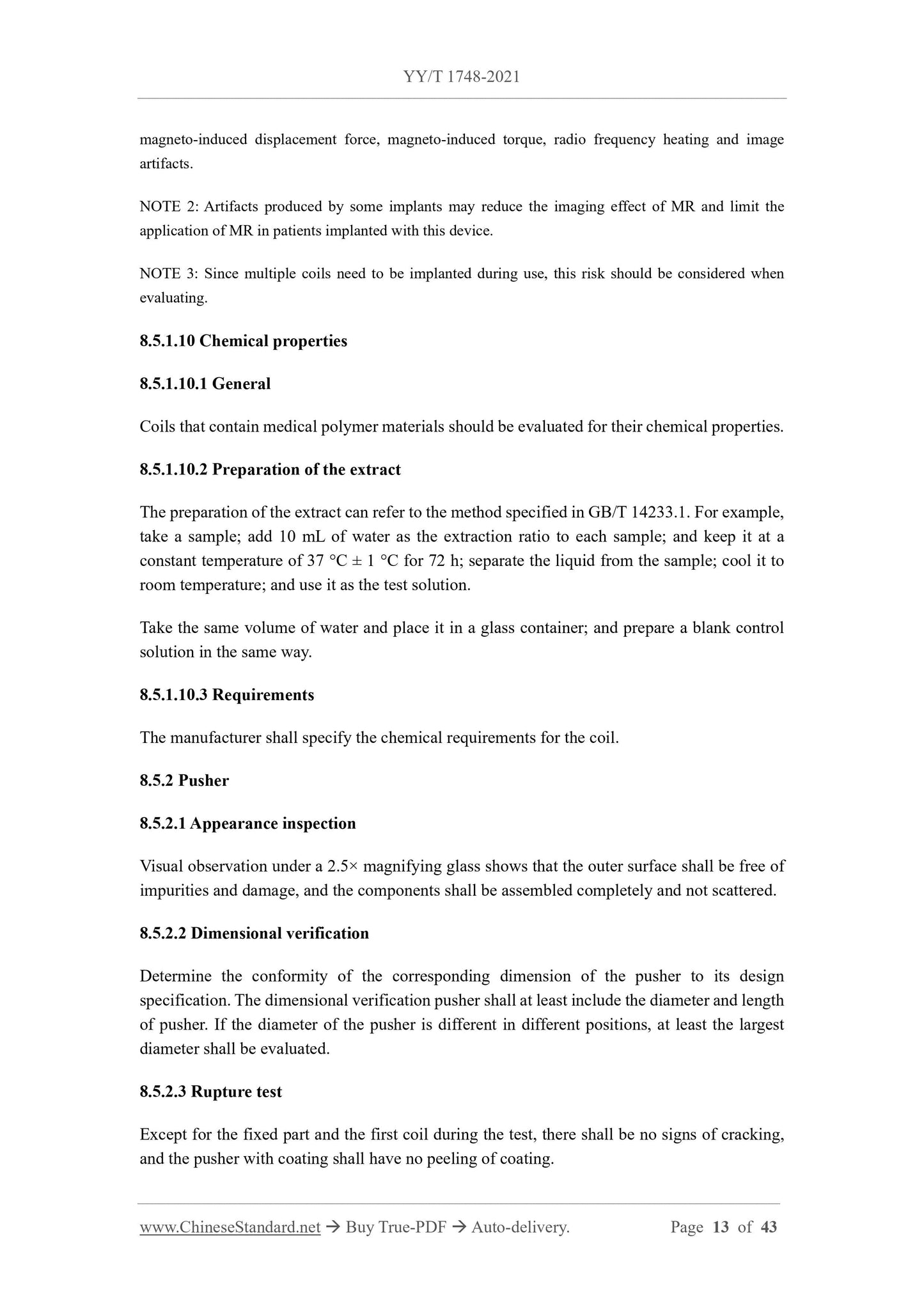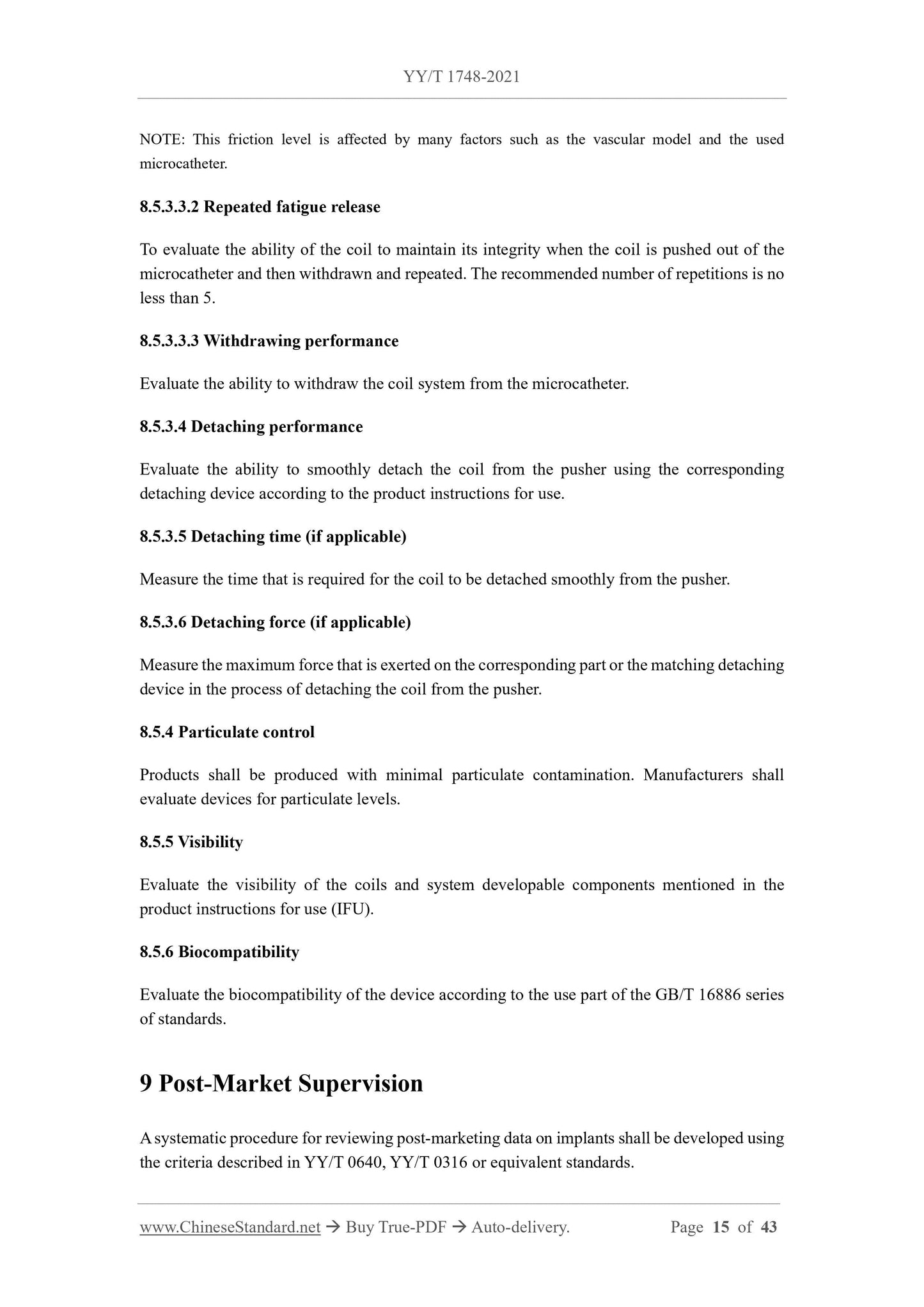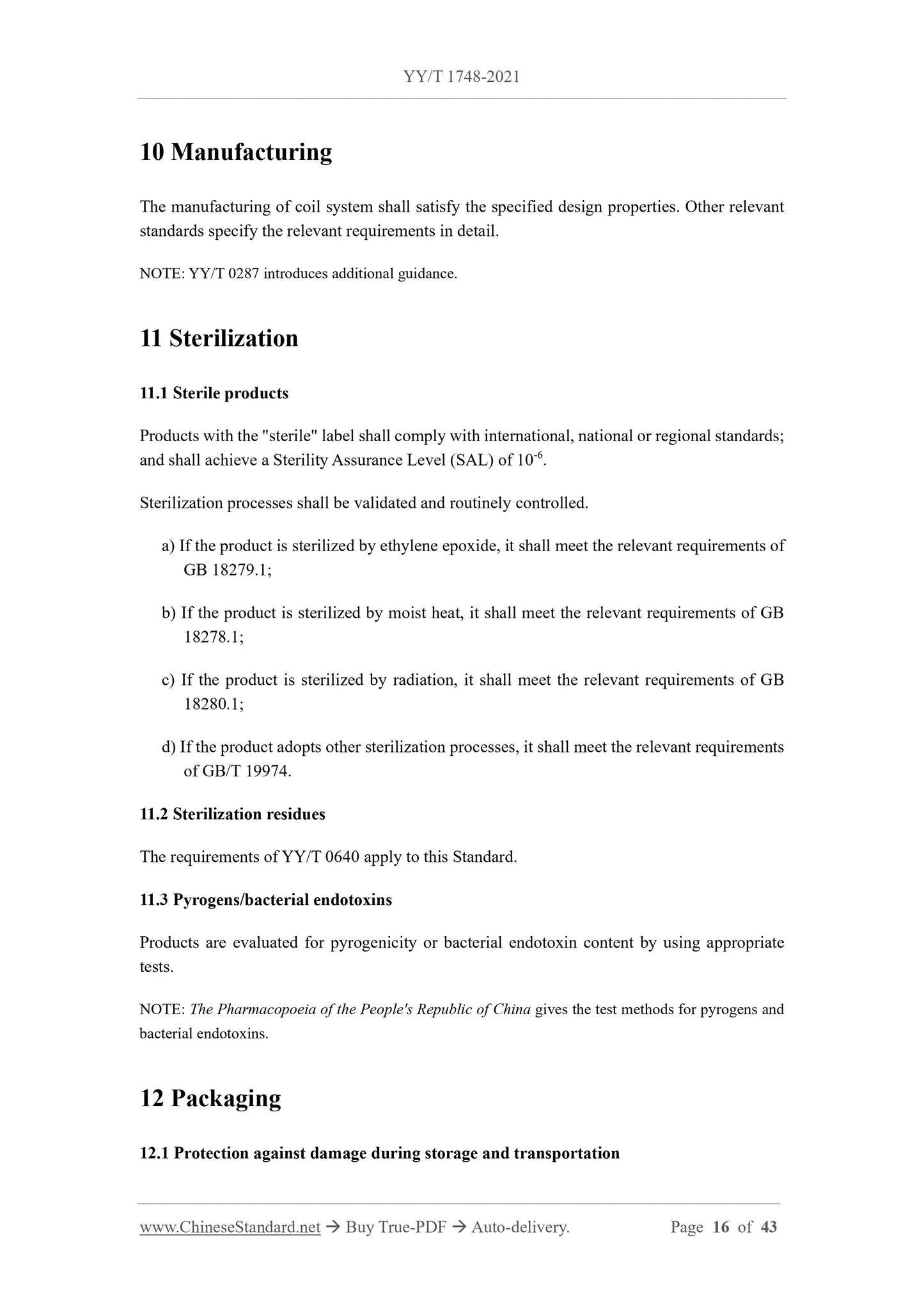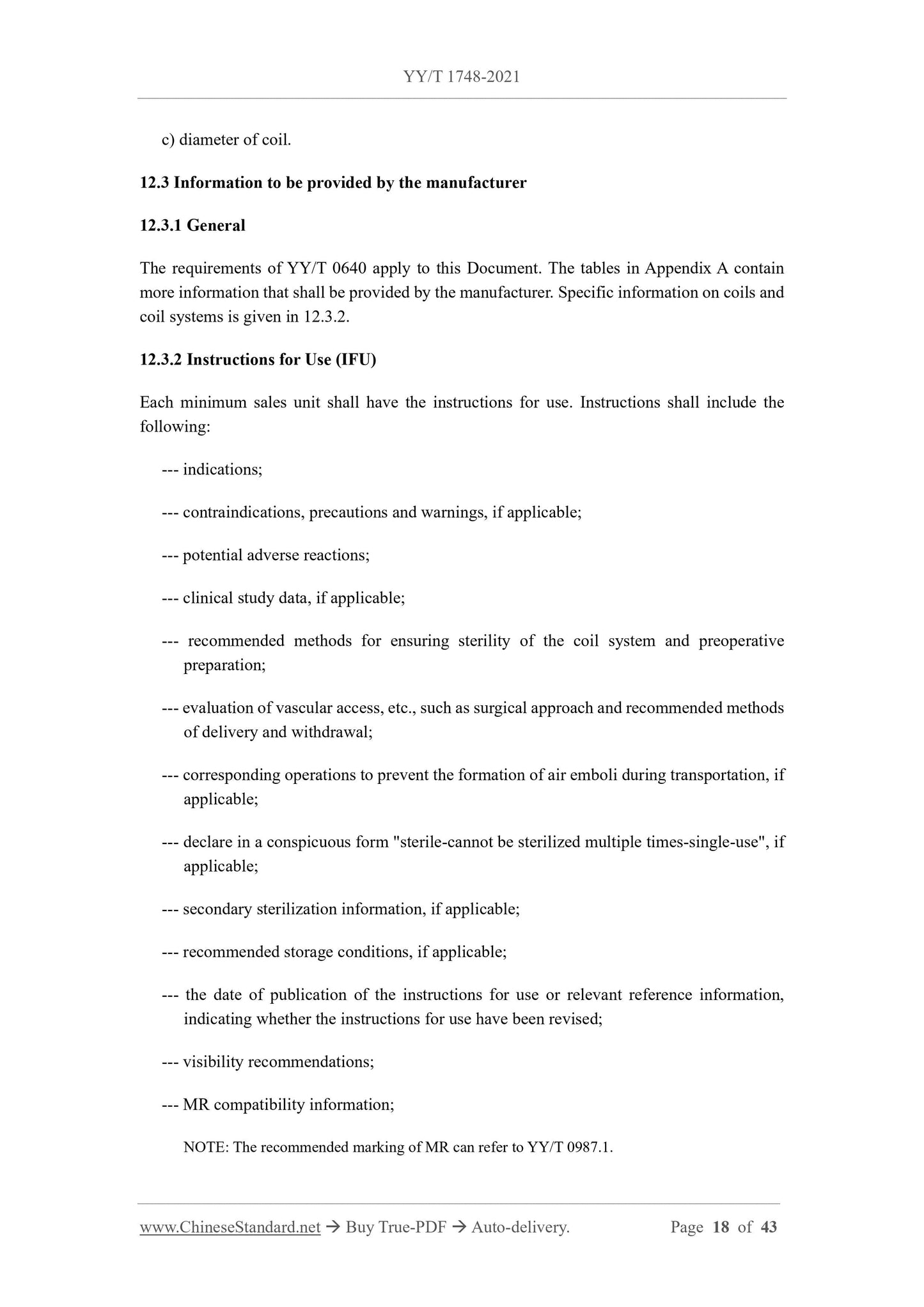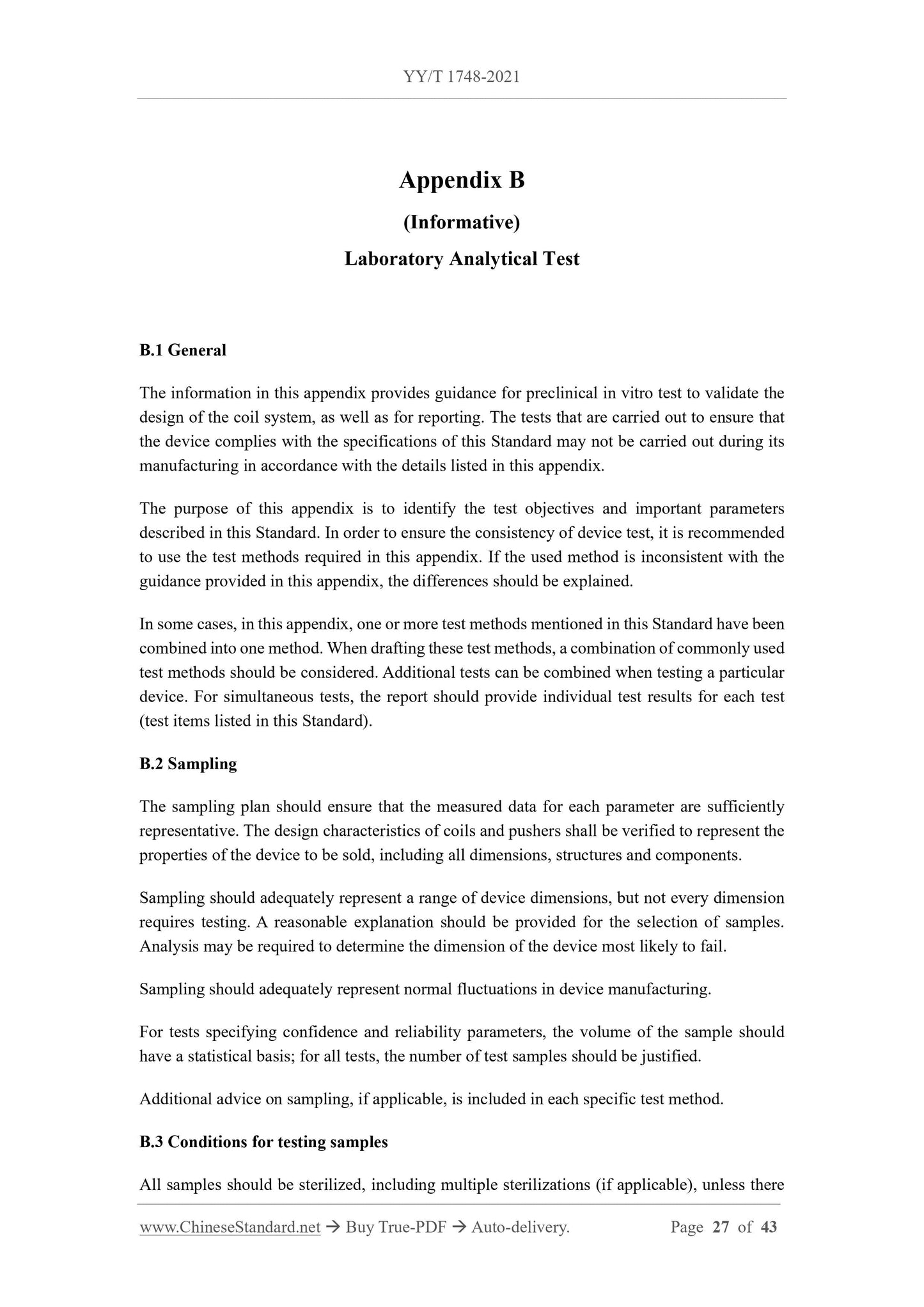1
/
of
12
www.ChineseStandard.us -- Field Test Asia Pte. Ltd.
YY/T 1748-2021 English PDF (YY/T1748-2021)
YY/T 1748-2021 English PDF (YY/T1748-2021)
Regular price
$440.00
Regular price
Sale price
$440.00
Unit price
/
per
Shipping calculated at checkout.
Couldn't load pickup availability
YY/T 1748-2021: Neurovascular implants - Intracranial embolization coils
Delivery: 9 seconds. Download (& Email) true-PDF + Invoice.
Get Quotation: Click YY/T 1748-2021 (Self-service in 1-minute)
Historical versions (Master-website): YY/T 1748-2021
Preview True-PDF (Reload/Scroll-down if blank)
YY/T 1748-2021
PHARMACEUTICAL INDUSTRY STANDARD
OF THE PEOPLE’S REPUBLIC OF CHINA
ICS 11.040.40
C 35
Neurovascular Implants – Intracranial Embolization Coils
神经血管植入物 颅内弹簧圈
ISSUED ON: SEPTEMBER 06, 2021
IMPLEMENTED ON: SEPTEMBER 01, 2022
Issued by: National Medical Products Administration
Table of Contents
Foreword ... 3
1 Scope ... 4
2 Normative References ... 4
3 Terms and Definitions ... 5
4 General Requirements ... 7
5 Intended Performance ... 8
6 Design Properties ... 8
7 Materials ... 9
8 Laboratory Design Evaluation ... 9
9 Post-Market Supervision ... 15
10 Manufacturing ... 16
11 Sterilization ... 16
12 Packaging ... 16
Appendix A (Informative) Relationship between Design Properties, Design Evaluation
and Potential Failure Mode ... 20
Appendix B (Informative) Laboratory Analytical Test ... 27
Bibliography ... 43
Neurovascular Implants – Intracranial Embolization Coils
1 Scope
This Standard specifies general requirements, design properties and laboratory design
evaluations for coils, pushers and coil systems. This Standard is applicable to coil products for
the treatment of intracranial aneurysms, arteriovenous fistulas, arteriovenous malformations
and other intracranial vascular diseases, as well as the pushers and introducer sheaths that are
matched with them.
This Standard does not apply to coil products for the treatment of other vascular aneurysms.
NOTE 1: Coil products used for other vascular aneurysms may refer to this Standard for implementation.
This Standard does not apply to devices that assist in the release of coils (referred to as releasers,
such as separation control boxes, etc.).
NOTE 2: For the releaser, the relevant standards or technical requirements shall be met. It is possible to
use a releaser as an auxiliary device in the design evaluation of the coil.
This Standard does not deal with drug-related content.
NOTE 3: For the pharmaceutical ingredients included in the product design, it shall be implemented in
accordance with the corresponding laws, regulations and other documents.
NOTE 4: YY/T 0640 specifies general requirements for the performance of passive surgical implants,
this Standard can be used as a supplement to YY/T 0640.
2 Normative References
The following documents are essential to the application of this document. For the dated
documents, only the versions with the dates indicated are applicable to this document; for the
undated documents, only the latest version (including all the amendments) is applicable to this
document.
GB/T 14233.1 Test Methods for Infusion Transfusion Injection Equipment for Medical
Use - Part 1: Chemical Analysis Methods
GB/T 16886 (all parts) Biological Evaluation of Medical Devices
GB 18278.1 Sterilization of Health Care Products - Moist Heat - Part 1: Requirements for
the Development, Validation and Routine Control of a Sterilization Process for Medical
Devices
GB 18279.1 Sterilization of Health Care Products - Ethylene Oxide - Part 1: Requirements
for Development, Validation and Routine Control of a Sterilization Process for Medical
Devices
GB 18280.1 Sterilization of Health Care Products – Radiation - Part 1: Requirements for
Development, Validation and Routine Control of a Sterilization Process for Medical
Devices
GB/T 19633.1 Packaging for Terminally Sterilized Medical Devices - Part 1:
Requirements for Materials, Sterile Barrier Systems and Packaging Systems
GB/T 19974 Sterilization of Health Care Products - General Requirement for
Characterization of a Sterilization Agent and the Development, Validation and Routine
Control of a Sterilization Process
YY/T 0316 Medical Devices - Application of Risk Management to Medical Devices
YY 0450.1-2020 Accessory Devices for Sterile Single - Use Intravascular Catheters - Part
1: Introducers
YY/T 0640 Non-Active Surgical Implants - General Requirements
YY/T 0695 Standard Test Method for Conducting Cyclic Potentiodynamic Polarization
Measurements to Determine the Corrosion Susceptibility of Small Implant Devices
3 Terms and Definitions
For the purposes of this Document, the terms and definitions given in YY/T 0640 and the
following apply.
3.1 Intracranial embolization coil
The passive surgical implant that is place on the intracranial vascular disease through the
catheter, with a spring-like structure for embolization.
3.2 Coil system
It includes coil, pusher and introducer sheath.
3.3 Primary coil
It is the most basic form of a coil that is formed by winding a metal wire.
3.4 Secondary shape
h) conformity of dimensions to design specifications;
i) component compatibility;
j) magnetic resonance compatibility;
k) visibility;
l) The coil system meets the requirements of the relevant parts of the GB/T 16886 series.
For the instruments that are used in conjunction with the detachment process of the coil, the
risks existing in the joint use of the coil shall be considered. Electrical safety shall be considered
for coils that use electrolytic or thermolytic detachment.
7 Materials
7.1 General
The requirements of YY/T 0640 apply to this Standard.
7.2 Coil
Manufacturers shall evaluate the materials that are used to manufacture the coils.
7.3 Pusher
The pusher should be made of materials that can contact blood. If the pusher is a multi-layer
structure, the outer layer that is expected to be exposed to blood shall be made of materials that
can contact blood.
8 Laboratory Design Evaluation
8.1 General
The requirements of YY/T 0640 apply to this Standard. Risk assessment shall be carried out in
accordance with the requirements of YY/T 0316.
A device evaluation strategy (DES) should be established. DES provides principles for the
selection of test items to evaluate device performance. This principle is based on the design
properties and potential failure modes of the device. DES can be presented in the form of a
table, where the column headings are explained in Table A.1 of Appendix A.
8.2 Sampling
The sampling plan shall ensure that the measurement data for each feature is adequately
representative. The design properties of the verification coil shall be representative of the device
to be released and cover all dimensions.
The samples selected for each test shall represent at least the worst case. The dimension of the
coil, the dimension of the pusher, the way of detachment, and the implantation conditions (e.g.,
target disease size and morphology) shall also be considered. Analysis is required as necessary
to identify the samples most likely to fail under specific implantation conditions.
Sampling should adequately represent normal fluctuations in device characteristics (e.g.,
multiple batches).
Sample selection should provide a reasonable explanation. For all tests, the number of test
samples shall be justified.
For the untested product attributes, reasons for not testing shall be given.
NOTE: Not all tests are applicable to all coil system designs, and manufacturers should determine
applicable tests based on device design properties and DES.
8.3 Sample treatment
All samples shall be sterilized, including multiple sterilizations (if applicable), unless there are
good reasons to use non-sterile samples.
Samples shall be subjected to treatment that may affect the test results before test.
When appropriate, test should be performed in a simulated physiological environment (e.g., a
temperature-controlled water bath).
8.4 Report
The purpose of this part is to report in accordance with national regulatory authorities.
Preclinical in vitro test reports should include a summary of all tests. The summary should
include the names of the various tests, as well as any reasons for omitting or replacing the tests
specified in Appendix B. The information in each test report should be based on a pre-designed
test plan.
The report should include a summary of the acceptance criteria, test results, and any potential
clinical significance of the test results, which may be presented in table form. The anatomical,
physiological and morphological conditions under which the device is intended to be used
should be considered when establishing acceptance criteria. The clinical applicability and
justification basis for the acceptance criteria for each test should be provided. A table of contents
should be provided, and each page should be numbered sequentially.
Each test report should include the following:
Measure the maximum force in the process of pulling a unit number of cilia from the coil.
8.5.1.5 Basket performance (if applicable)
Qualitatively evaluate the ability of the coil to form the desired configuration after being pushed
out of the pipeline.
8.5.1.6 Corrosion
Evaluate the corrosion susceptibility of coils in real or simulated environments. Corrosion
mechanisms may include pitting, friction corrosion, crevice corrosion, and galvanic corrosion.
Potential adverse clinical effects due to corrosion products should be considered. Galvanic
corrosion shall be assessed when dissimilar metals are in contact based on device design or the
requirements of the Instructions for Use (IFU). Corrosion evaluation includes, but is not limited
to, evaluation of test results, literature evaluation, and evaluation of the material's past clinical
performance. Guidelines for corrosion evaluation are presented in many sources (e.g., literature,
textbooks, standards, regulatory guidance documents).
It is recommended to use the method specified in YY/T 0695 to evaluate the breakdown
potential of the coil.
NOTE: GB/T 24196, ASTM B117, ASTM F746, ASTM G5, ASTM G15, ASTM G61, ASTM G71 and
ASTM G102 introduce additional guidance.
8.5.1.7 Coating integrity (if applicable)
For coils covered with a coating, the manufacturer shall evaluate the integrity of the coating
during simulated use. It is recommended that the simulated use process involves repeated
fatigue relief (see 8.5.3.3.2).
8.5.1.8 Swelling properties (if applicable)
For coils that contain hydrogels or other coils that expand in volume during use, the
manufacturer shall evaluate the swelling properties of the product.
8.5.1.9 Magnetic resonance (MR) compatibility
To evaluate the safety and compatibility of implants in the MR environment, the following risks
shall be considered but not limited to:
a) magneto-induced displacement force and magneto-induced torque;
b) radio frequency heating;
c) Degraded image quality (artifact).
NOTE 1: YY/T 0987.2, YY/T 0987.5, YY/T 0987.4 and YY/T 0987.3 introduce additional guidance on
magneto-induced displacement force, magneto-induced torque, radio frequency heating and image
artifacts.
NOTE 2: Artifacts produced by some implants may reduce the imaging effect of MR and limit the
application of MR in patients implanted with this device.
NOTE 3: Since multiple coils need to be implanted during use, this risk should be considered when
evaluating.
8.5.1.10 Chemical properties
8.5.1.10.1 General
Coils that contain medical polymer materials should be evaluated for their chemical properties.
8.5.1.10.2 Preparation of the extract
The preparation of the extract can refer to the method specified in GB/T 14233.1. For example,
take a sample; add 10 mL of water as the extraction ratio to each sample; and keep it at a
constant temperature of 37 °C ± 1 °C for 72 h; separate the liquid from the sample; cool it to
room temperature; and use it as the test solution.
Take the same volume of water and place it in a glass container; and prepare a blank control
solution in the same way.
8.5.1.10.3 Requirements
The manufacturer shall specify the chemical requirements for the coil.
8.5.2 Pusher
8.5.2.1 Appearance inspection
Visual observation under a 2.5× magnifying glass shows that the outer surface shall be free of
impurities and damage, and the components shall be assembled completely and not scattered.
8.5.2.2 Dimensional verification
Determine the conformity of the corresponding dimension of the pusher to its design
specification. The dimensional verification pusher shall at least include the diameter and length
of pusher. If the diameter of the pusher is different in different positions, at least the largest
diameter shall be evaluated.
8.5.2.3 Rupture test
Except for the fixed part and the first coil during the test, there shall be no signs of cracking,
and the pusher with coating shall have no peeling of coating.
NOTE: This friction level is affected by many factors such as the vascular model and the used
microcatheter.
8.5.3.3.2 Repeated fatigue release
To evaluate the ability of the coil to maintain its integrity when the coil is pushed out of the
microcatheter and then withdrawn and repeated. The recommended number of repetitions is no
less than 5.
8.5.3.3.3 Withdrawing performance
Evaluate the ability to withdraw the coil system from the microcatheter.
8.5.3.4 Detaching performance
Evaluate the ability to smoothly detach the coil from the pusher using the corresponding
detaching device according to the product instructions for use.
8.5.3.5 Detaching time (if applicable)
Measure the time that is required for the coil to be detached smoothly from the pusher.
8.5.3.6 Detaching force (if applicable)
Measure the maximum force that is exerted on the corresponding part or the matching detaching
device in the process of detaching the coil from the pusher.
8.5.4 Particulate control
Products shall be produced with minimal particulate contamination. Manufacturers shall
evaluate devices for particulate levels.
8.5.5 Visibility
Evaluate the visibility of the coils and system developable components mentioned in the
product instructions for use (IFU).
8.5.6 Biocompatibility
Evaluate the biocompatibility of the device according to the use part of the GB/T 16886 series
of standards.
9 Post-Market Supervision
A systematic procedure for reviewing post-marketing data on implants shall be developed using
the criteria described in YY/T 0640, YY/T 0316 or equ...
Delivery: 9 seconds. Download (& Email) true-PDF + Invoice.
Get Quotation: Click YY/T 1748-2021 (Self-service in 1-minute)
Historical versions (Master-website): YY/T 1748-2021
Preview True-PDF (Reload/Scroll-down if blank)
YY/T 1748-2021
PHARMACEUTICAL INDUSTRY STANDARD
OF THE PEOPLE’S REPUBLIC OF CHINA
ICS 11.040.40
C 35
Neurovascular Implants – Intracranial Embolization Coils
神经血管植入物 颅内弹簧圈
ISSUED ON: SEPTEMBER 06, 2021
IMPLEMENTED ON: SEPTEMBER 01, 2022
Issued by: National Medical Products Administration
Table of Contents
Foreword ... 3
1 Scope ... 4
2 Normative References ... 4
3 Terms and Definitions ... 5
4 General Requirements ... 7
5 Intended Performance ... 8
6 Design Properties ... 8
7 Materials ... 9
8 Laboratory Design Evaluation ... 9
9 Post-Market Supervision ... 15
10 Manufacturing ... 16
11 Sterilization ... 16
12 Packaging ... 16
Appendix A (Informative) Relationship between Design Properties, Design Evaluation
and Potential Failure Mode ... 20
Appendix B (Informative) Laboratory Analytical Test ... 27
Bibliography ... 43
Neurovascular Implants – Intracranial Embolization Coils
1 Scope
This Standard specifies general requirements, design properties and laboratory design
evaluations for coils, pushers and coil systems. This Standard is applicable to coil products for
the treatment of intracranial aneurysms, arteriovenous fistulas, arteriovenous malformations
and other intracranial vascular diseases, as well as the pushers and introducer sheaths that are
matched with them.
This Standard does not apply to coil products for the treatment of other vascular aneurysms.
NOTE 1: Coil products used for other vascular aneurysms may refer to this Standard for implementation.
This Standard does not apply to devices that assist in the release of coils (referred to as releasers,
such as separation control boxes, etc.).
NOTE 2: For the releaser, the relevant standards or technical requirements shall be met. It is possible to
use a releaser as an auxiliary device in the design evaluation of the coil.
This Standard does not deal with drug-related content.
NOTE 3: For the pharmaceutical ingredients included in the product design, it shall be implemented in
accordance with the corresponding laws, regulations and other documents.
NOTE 4: YY/T 0640 specifies general requirements for the performance of passive surgical implants,
this Standard can be used as a supplement to YY/T 0640.
2 Normative References
The following documents are essential to the application of this document. For the dated
documents, only the versions with the dates indicated are applicable to this document; for the
undated documents, only the latest version (including all the amendments) is applicable to this
document.
GB/T 14233.1 Test Methods for Infusion Transfusion Injection Equipment for Medical
Use - Part 1: Chemical Analysis Methods
GB/T 16886 (all parts) Biological Evaluation of Medical Devices
GB 18278.1 Sterilization of Health Care Products - Moist Heat - Part 1: Requirements for
the Development, Validation and Routine Control of a Sterilization Process for Medical
Devices
GB 18279.1 Sterilization of Health Care Products - Ethylene Oxide - Part 1: Requirements
for Development, Validation and Routine Control of a Sterilization Process for Medical
Devices
GB 18280.1 Sterilization of Health Care Products – Radiation - Part 1: Requirements for
Development, Validation and Routine Control of a Sterilization Process for Medical
Devices
GB/T 19633.1 Packaging for Terminally Sterilized Medical Devices - Part 1:
Requirements for Materials, Sterile Barrier Systems and Packaging Systems
GB/T 19974 Sterilization of Health Care Products - General Requirement for
Characterization of a Sterilization Agent and the Development, Validation and Routine
Control of a Sterilization Process
YY/T 0316 Medical Devices - Application of Risk Management to Medical Devices
YY 0450.1-2020 Accessory Devices for Sterile Single - Use Intravascular Catheters - Part
1: Introducers
YY/T 0640 Non-Active Surgical Implants - General Requirements
YY/T 0695 Standard Test Method for Conducting Cyclic Potentiodynamic Polarization
Measurements to Determine the Corrosion Susceptibility of Small Implant Devices
3 Terms and Definitions
For the purposes of this Document, the terms and definitions given in YY/T 0640 and the
following apply.
3.1 Intracranial embolization coil
The passive surgical implant that is place on the intracranial vascular disease through the
catheter, with a spring-like structure for embolization.
3.2 Coil system
It includes coil, pusher and introducer sheath.
3.3 Primary coil
It is the most basic form of a coil that is formed by winding a metal wire.
3.4 Secondary shape
h) conformity of dimensions to design specifications;
i) component compatibility;
j) magnetic resonance compatibility;
k) visibility;
l) The coil system meets the requirements of the relevant parts of the GB/T 16886 series.
For the instruments that are used in conjunction with the detachment process of the coil, the
risks existing in the joint use of the coil shall be considered. Electrical safety shall be considered
for coils that use electrolytic or thermolytic detachment.
7 Materials
7.1 General
The requirements of YY/T 0640 apply to this Standard.
7.2 Coil
Manufacturers shall evaluate the materials that are used to manufacture the coils.
7.3 Pusher
The pusher should be made of materials that can contact blood. If the pusher is a multi-layer
structure, the outer layer that is expected to be exposed to blood shall be made of materials that
can contact blood.
8 Laboratory Design Evaluation
8.1 General
The requirements of YY/T 0640 apply to this Standard. Risk assessment shall be carried out in
accordance with the requirements of YY/T 0316.
A device evaluation strategy (DES) should be established. DES provides principles for the
selection of test items to evaluate device performance. This principle is based on the design
properties and potential failure modes of the device. DES can be presented in the form of a
table, where the column headings are explained in Table A.1 of Appendix A.
8.2 Sampling
The sampling plan shall ensure that the measurement data for each feature is adequately
representative. The design properties of the verification coil shall be representative of the device
to be released and cover all dimensions.
The samples selected for each test shall represent at least the worst case. The dimension of the
coil, the dimension of the pusher, the way of detachment, and the implantation conditions (e.g.,
target disease size and morphology) shall also be considered. Analysis is required as necessary
to identify the samples most likely to fail under specific implantation conditions.
Sampling should adequately represent normal fluctuations in device characteristics (e.g.,
multiple batches).
Sample selection should provide a reasonable explanation. For all tests, the number of test
samples shall be justified.
For the untested product attributes, reasons for not testing shall be given.
NOTE: Not all tests are applicable to all coil system designs, and manufacturers should determine
applicable tests based on device design properties and DES.
8.3 Sample treatment
All samples shall be sterilized, including multiple sterilizations (if applicable), unless there are
good reasons to use non-sterile samples.
Samples shall be subjected to treatment that may affect the test results before test.
When appropriate, test should be performed in a simulated physiological environment (e.g., a
temperature-controlled water bath).
8.4 Report
The purpose of this part is to report in accordance with national regulatory authorities.
Preclinical in vitro test reports should include a summary of all tests. The summary should
include the names of the various tests, as well as any reasons for omitting or replacing the tests
specified in Appendix B. The information in each test report should be based on a pre-designed
test plan.
The report should include a summary of the acceptance criteria, test results, and any potential
clinical significance of the test results, which may be presented in table form. The anatomical,
physiological and morphological conditions under which the device is intended to be used
should be considered when establishing acceptance criteria. The clinical applicability and
justification basis for the acceptance criteria for each test should be provided. A table of contents
should be provided, and each page should be numbered sequentially.
Each test report should include the following:
Measure the maximum force in the process of pulling a unit number of cilia from the coil.
8.5.1.5 Basket performance (if applicable)
Qualitatively evaluate the ability of the coil to form the desired configuration after being pushed
out of the pipeline.
8.5.1.6 Corrosion
Evaluate the corrosion susceptibility of coils in real or simulated environments. Corrosion
mechanisms may include pitting, friction corrosion, crevice corrosion, and galvanic corrosion.
Potential adverse clinical effects due to corrosion products should be considered. Galvanic
corrosion shall be assessed when dissimilar metals are in contact based on device design or the
requirements of the Instructions for Use (IFU). Corrosion evaluation includes, but is not limited
to, evaluation of test results, literature evaluation, and evaluation of the material's past clinical
performance. Guidelines for corrosion evaluation are presented in many sources (e.g., literature,
textbooks, standards, regulatory guidance documents).
It is recommended to use the method specified in YY/T 0695 to evaluate the breakdown
potential of the coil.
NOTE: GB/T 24196, ASTM B117, ASTM F746, ASTM G5, ASTM G15, ASTM G61, ASTM G71 and
ASTM G102 introduce additional guidance.
8.5.1.7 Coating integrity (if applicable)
For coils covered with a coating, the manufacturer shall evaluate the integrity of the coating
during simulated use. It is recommended that the simulated use process involves repeated
fatigue relief (see 8.5.3.3.2).
8.5.1.8 Swelling properties (if applicable)
For coils that contain hydrogels or other coils that expand in volume during use, the
manufacturer shall evaluate the swelling properties of the product.
8.5.1.9 Magnetic resonance (MR) compatibility
To evaluate the safety and compatibility of implants in the MR environment, the following risks
shall be considered but not limited to:
a) magneto-induced displacement force and magneto-induced torque;
b) radio frequency heating;
c) Degraded image quality (artifact).
NOTE 1: YY/T 0987.2, YY/T 0987.5, YY/T 0987.4 and YY/T 0987.3 introduce additional guidance on
magneto-induced displacement force, magneto-induced torque, radio frequency heating and image
artifacts.
NOTE 2: Artifacts produced by some implants may reduce the imaging effect of MR and limit the
application of MR in patients implanted with this device.
NOTE 3: Since multiple coils need to be implanted during use, this risk should be considered when
evaluating.
8.5.1.10 Chemical properties
8.5.1.10.1 General
Coils that contain medical polymer materials should be evaluated for their chemical properties.
8.5.1.10.2 Preparation of the extract
The preparation of the extract can refer to the method specified in GB/T 14233.1. For example,
take a sample; add 10 mL of water as the extraction ratio to each sample; and keep it at a
constant temperature of 37 °C ± 1 °C for 72 h; separate the liquid from the sample; cool it to
room temperature; and use it as the test solution.
Take the same volume of water and place it in a glass container; and prepare a blank control
solution in the same way.
8.5.1.10.3 Requirements
The manufacturer shall specify the chemical requirements for the coil.
8.5.2 Pusher
8.5.2.1 Appearance inspection
Visual observation under a 2.5× magnifying glass shows that the outer surface shall be free of
impurities and damage, and the components shall be assembled completely and not scattered.
8.5.2.2 Dimensional verification
Determine the conformity of the corresponding dimension of the pusher to its design
specification. The dimensional verification pusher shall at least include the diameter and length
of pusher. If the diameter of the pusher is different in different positions, at least the largest
diameter shall be evaluated.
8.5.2.3 Rupture test
Except for the fixed part and the first coil during the test, there shall be no signs of cracking,
and the pusher with coating shall have no peeling of coating.
NOTE: This friction level is affected by many factors such as the vascular model and the used
microcatheter.
8.5.3.3.2 Repeated fatigue release
To evaluate the ability of the coil to maintain its integrity when the coil is pushed out of the
microcatheter and then withdrawn and repeated. The recommended number of repetitions is no
less than 5.
8.5.3.3.3 Withdrawing performance
Evaluate the ability to withdraw the coil system from the microcatheter.
8.5.3.4 Detaching performance
Evaluate the ability to smoothly detach the coil from the pusher using the corresponding
detaching device according to the product instructions for use.
8.5.3.5 Detaching time (if applicable)
Measure the time that is required for the coil to be detached smoothly from the pusher.
8.5.3.6 Detaching force (if applicable)
Measure the maximum force that is exerted on the corresponding part or the matching detaching
device in the process of detaching the coil from the pusher.
8.5.4 Particulate control
Products shall be produced with minimal particulate contamination. Manufacturers shall
evaluate devices for particulate levels.
8.5.5 Visibility
Evaluate the visibility of the coils and system developable components mentioned in the
product instructions for use (IFU).
8.5.6 Biocompatibility
Evaluate the biocompatibility of the device according to the use part of the GB/T 16886 series
of standards.
9 Post-Market Supervision
A systematic procedure for reviewing post-marketing data on implants shall be developed using
the criteria described in YY/T 0640, YY/T 0316 or equ...
Share
